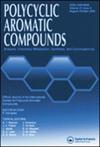New Triazole Hybrids as Anticancer Agents Targeting Thymidylate Synthase: Synthesis, Biological and Molecular Docking Studies
IF 2.6
3区 化学
Q2 CHEMISTRY, ORGANIC
引用次数: 0
Abstract
The present work describes the synthesis and antiproliferative activity of new triazole hybrids. The anticancer results showed that the synthesized hybrids were most sensitive toward colon HCT-116 followed by liver HepG2 and breast MCF-7 carcinomas. Among all the hybrids, compound 10 resulted in remarkable cytotoxicity with IC50 of 1.14 μM, six times higher than reference drug, Doxorubicin (IC50 of 6.96 μM) and also emerged as most potent TS inhibitor with IC50 0.54 μM. In order to inquire its effect on intracellular mechanism, cell cycle and apoptosis studies were performed. Compound 10 treated HCT-116 cells caused remarkable increase in cell distribution in G1 phase, however it decreases both S and G2 population with early and late apoptosis. The study was supported by docking study where compound 10 revealed highest binding affinity and interacted with Arg50, Arg174, Asp218, Cys195, and Ser216, essential for the TS activity. These outcomes suggest that compound 10 acts as a TS inhibitor and could be promising target for cancer therapy.
靶向胸苷酸合成酶的新型三唑类抗癌药物:合成、生物学和分子对接研究
本文报道了新型三唑类化合物的合成及其抗增殖活性。抗癌结果显示,合成的杂交种对结肠癌HCT-116最敏感,其次是肝癌HepG2和乳腺癌MCF-7。其中,化合物10的IC50值为1.14 μM,是参比药阿霉素(6.96 μM)的6倍,也是最有效的TS抑制剂,IC50值为0.54 μM。为了探讨其对细胞内机制的影响,进行了细胞周期和凋亡的研究。化合物10处理的HCT-116细胞在G1期细胞分布明显增加,但在早期和晚期凋亡中均减少S和G2群体。该研究得到对接研究的支持,化合物10显示出最高的结合亲和力,并与TS活性必需的Arg50, Arg174, Asp218, Cys195和Ser216相互作用。这些结果表明,化合物10作为一种TS抑制剂,可能是癌症治疗的有希望的靶点。
本文章由计算机程序翻译,如有差异,请以英文原文为准。
求助全文
约1分钟内获得全文
求助全文
来源期刊

Polycyclic Aromatic Compounds
化学-有机化学
CiteScore
3.70
自引率
20.80%
发文量
412
审稿时长
3 months
期刊介绍:
The purpose of Polycyclic Aromatic Compounds is to provide an international and interdisciplinary forum for all aspects of research related to polycyclic aromatic compounds (PAC). Topics range from fundamental research in chemistry (including synthetic and theoretical chemistry) and physics (including astrophysics), as well as thermodynamics, spectroscopy, analytical methods, and biology to applied studies in environmental science, biochemistry, toxicology, and industry. Polycyclic Aromatic Compounds has an outstanding Editorial Board and offers a rapid and efficient peer review process, as well as a flexible open access policy.
 求助内容:
求助内容: 应助结果提醒方式:
应助结果提醒方式:


